TLS Explained: TLS 1.2 vs TLS 1.3
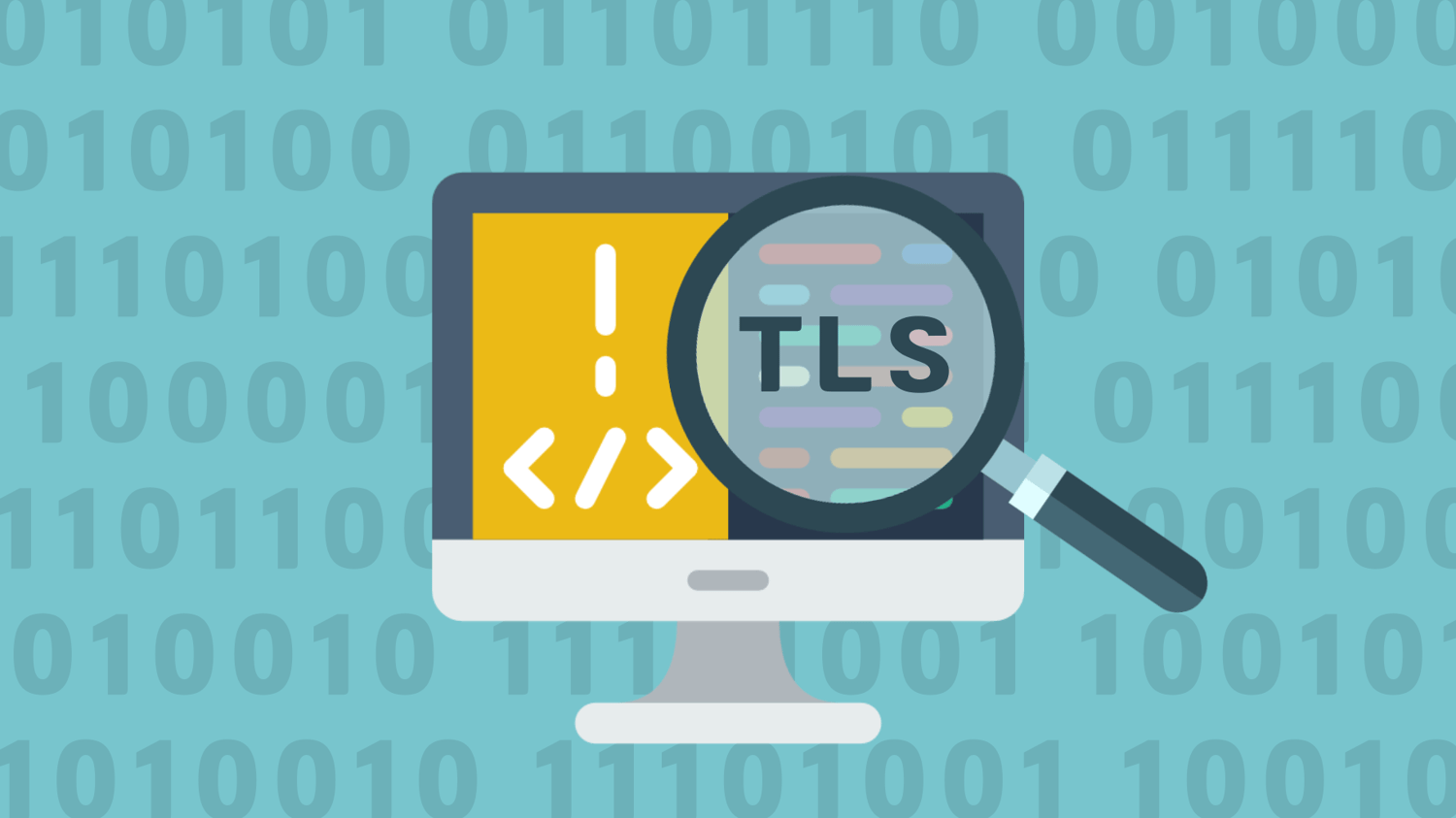
The Transport Layer Security (TLS) protocol, including its iterations TLS 1.2 and TLS 1.3, is fundamental to securing Internet communications in an era where the Internet is a vital part of our daily routines. TLS acts like a protective shield for our online activities, from chatting and shopping to learning and working. In this article, we will look into what TLS is, its evolution, the impact of TLS 1.3 on Internet security, it’s difference from TLS 1.2, and more. We will also review X-VPN's upgrade to TLS 1.3 and the impact it has on security and performance.
What is TLS?
Transport Layer Security (TLS) is a method of encryption that provides end-to-end security for data transmitted between applications over the Internet. It is considered the successor to the now-deprecated Secure Sockets Layer (SSL), a cornerstone of secure Internet communications. TLS is most commonly used to secure web browsing but also protects email, instant messaging, and voice-over IP communications.
TLS guarantees privacy and data integrity by encrypting data through the use of a TLS tunnel to prevent eavesdropping and tampering. This protects sensitive data like login credentials, financial transactions, and personal correspondence. This encryption is particularly important in today's era, where cyber threats are getting increasingly sophisticated and pervasive.
The upgrade from TLS 1.2 to TLS 1.3 has brought significant improvements in security and performance. TLS 1.3 has streamlined the handshake process, reduced latency, and removed outdated cipher suites, making it more resistant to attacks and faster in establishing secure connections. These enhancements make TLS 1.3 an essential tool for maintaining the security and integrity of Internet communications.
TLS 1.2 vs TLS 1.3
Here is a detailed overlook of the key improvements TLS 1.3 provides over older TLS versions
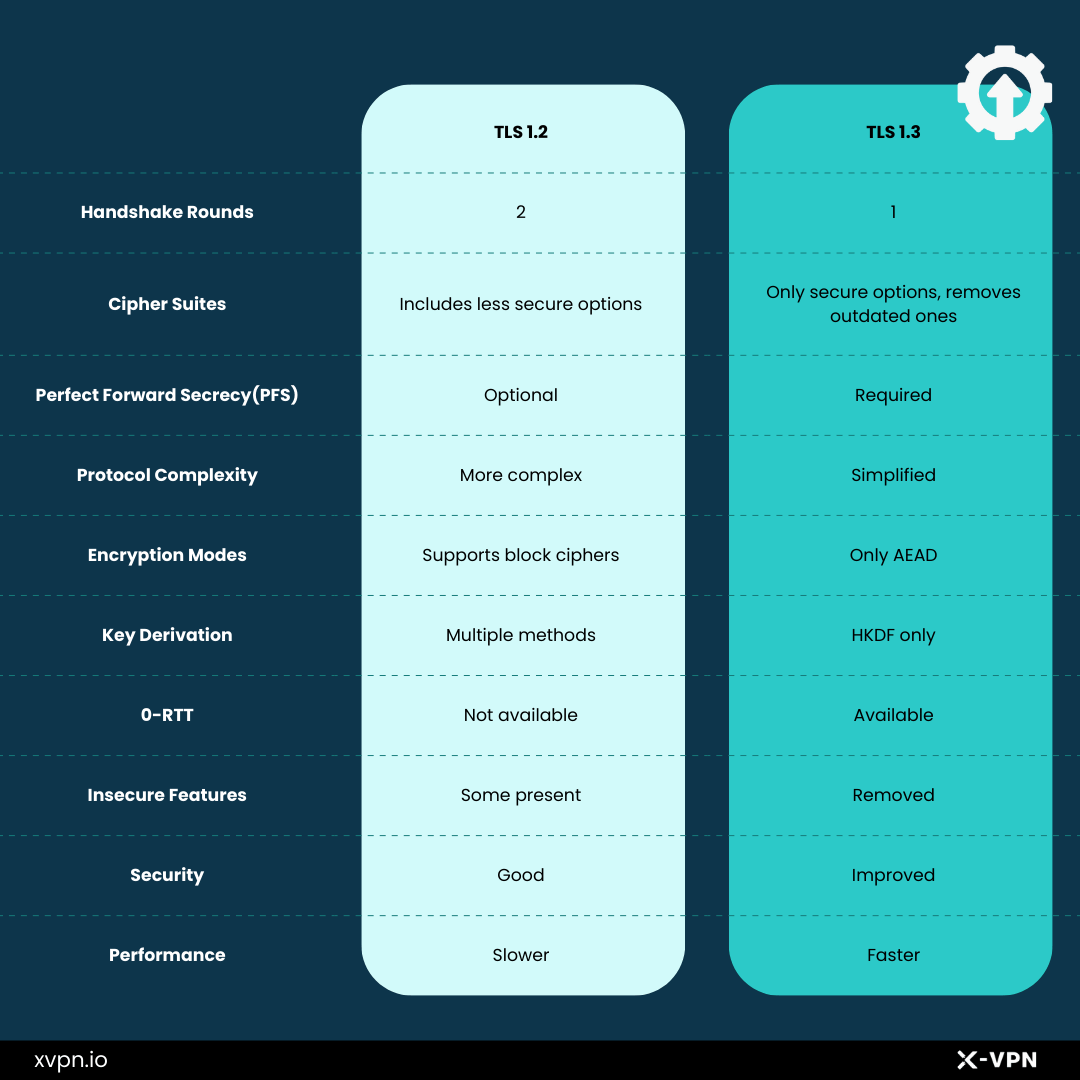
Advantages of using TLS 1.3 over TLS 1.2
TLS 1.3 offers several advantages over TLS 1.2, enhancing both security and performance:
· Faster handshake: TLS 1.3 reduces the handshake process to a single round trip, compared to TLS 1.2's two round trips, speeding up secure connections.
· Enhanced security: TLS 1.3 removes outdated cipher suites and mandates the use of Perfect Forward Secrecy (PFS), which protects past communications even if future keys are compromised.
· Simplified cipher suites: TLS 1.3 supports a smaller set of more secure cipher suites, eliminating weaker ones that were part of TLS 1.2.
· 0-RTT resumption: TLS 1.3 introduces Zero Round Trip Time (0-RTT), allowing clients to send encrypted data to the server during the first handshake, which can improve performance for returning visitors.
· Removal of insecure features: TLS 1.3 removes features that were part of TLS 1.2 but were found to be insecure, such as certain encryption modes and data compression.
· Resistance to attacks: TLS 1.3 provides better resistance against common attacks like eavesdropping, tampering, and forgery.
· Performance improvements: The streamlined handshake process and more efficient encryption methods in TLS 1.3 lead to reduced latency and improved performance in applications.
In summary, TLS 1.3 is designed to be faster and more secure than TLS 1.2, making it a better choice for protecting Internet communications.
The evolution of TLS versions
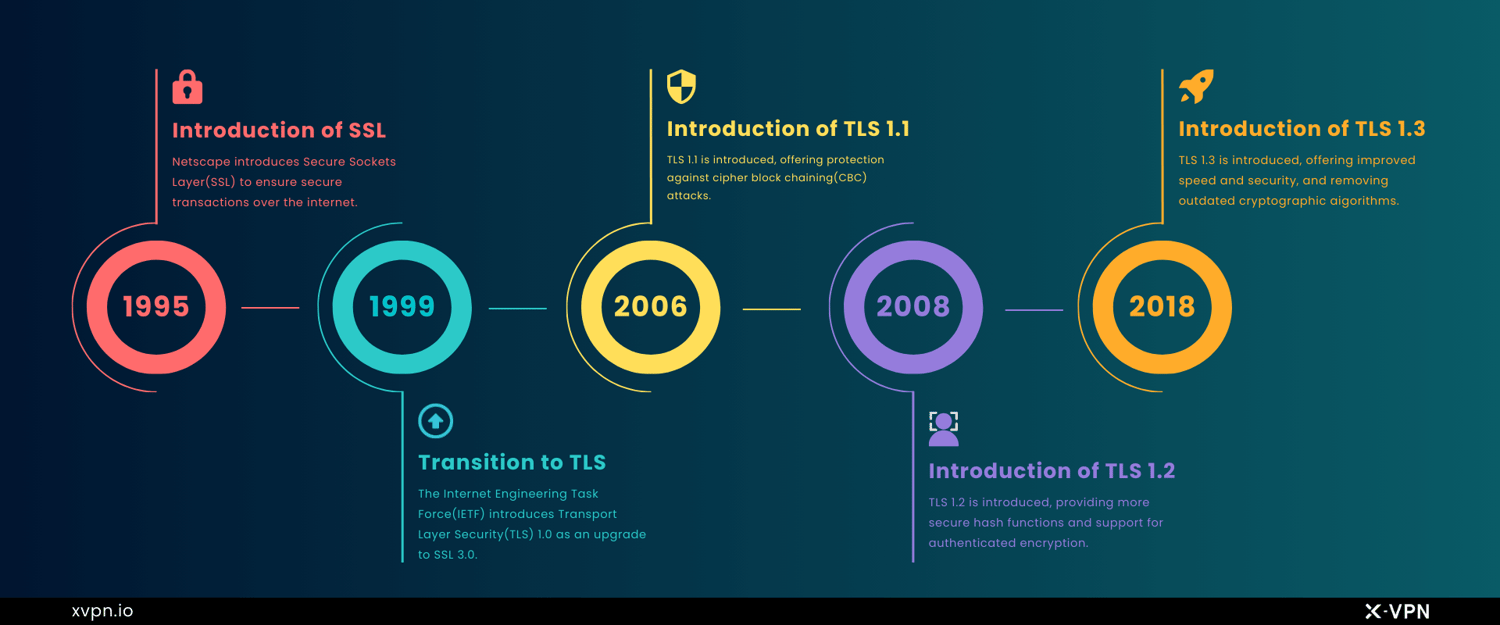
Secure Sockets Layer (SSL) was first introduced by Netscape in 1994 with the primary objective of securing data transmission over the Internet. Subsequently, in 1995 and 1996, SSL 2.0 and SSL 3.0 versions were released, respectively. However, these versions were later found to be vulnerable, necessitating the development of a more secure solution.
In 1999, the Transport Layer Security (TLS) was introduced as an upgrade to SSL 3.0. TLS 1.0 incorporated significant improvements over SSL 3.0, rendering interoperability between the two infeasible. Over the years, TLS continued to evolve, with successive versions like TLS 1.1, 1.2, and 1.3, each offering improved security and performance.
The shift from SSL to TLS was a response to the need for a more secure and efficient protocol to safeguard Internet communications. SSL's vulnerabilities, exemplified by the BEAST and BREACH attacks, highlighted the need for a protocol that could provide more robust security measures. The TLS protocol offered the necessary improvements and has since become the preferred protocol for secure Internet communications.
TLS vs SSL
TLS and SSL are cryptographic technologies that establish secure communication channels across a network. They encrypt data transmitted between a client and a server, ensuring confidentiality and tamper-proofing. TLS and SSL are widely used to secure online transactions and protect sensitive information, making them essential for businesses and organizations prioritizing data security. However, there are several key differences between them:
· Version: SSL is TLS's precursor. TLS 1.0, often known as SSL 3.1, is built on the foundation of SSL 3.0.
· Security: TLS is considered more secure than SSL. SSL has known security vulnerabilities, which led to its deprecation.
· Cipher suites: SSL and TLS are cryptographic protocols used for secure connections. They use different sets of cipher suites, which are combinations of encryption, key exchange, and message authentication algorithms. TLS 1.3 enhances encryption with Perfect Forward Secrecy, providing an extra layer of security to communications.
· Message authentication: SSL uses the MD5 algorithm for message authentication, while TLS uses the more secure SHA-256 algorithm.
· Alert messages: SSL sends alert messages in plain text, making them readable by anyone who intercepts them. In contrast, TLS encrypts alert messages, ensuring that only authorized parties can read them.
· Handshake process: The TLS handshake process is more efficient and secure compared to SSL.
In brief, while both SSL and TLS attempt to offer secure network communication, TLS is regarded as the more secure and efficient protocol.
X-VPN's upgrade to TLS 1.3: Speed, encryption, and unblock ability
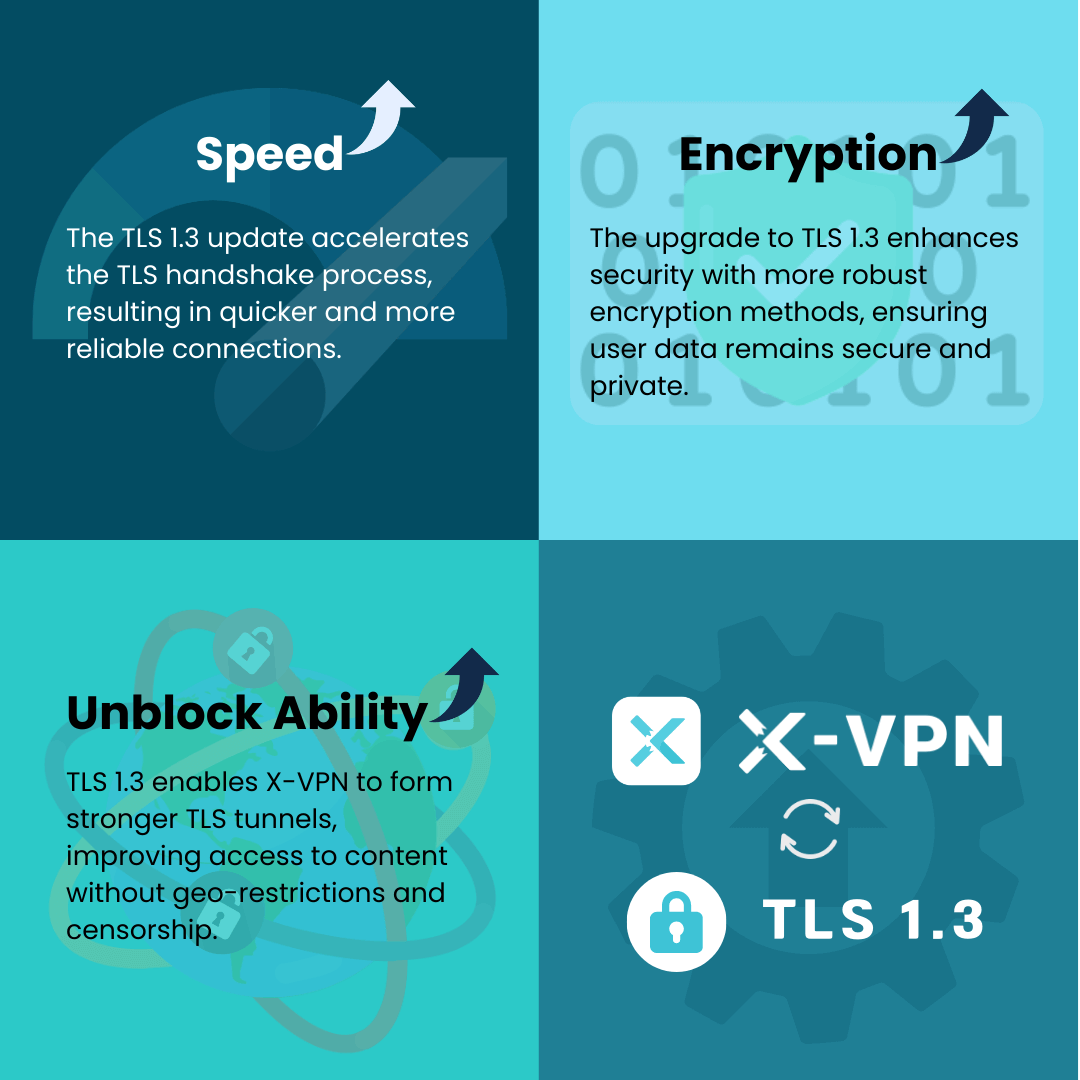
X-VPN has implemented TLS 1.3 to enhance the security and performance of its service on all platforms. It has also introduced support for two new features–Customized Domains and Certification Encryption. TLS 1.3 is the latest version of the Transport Layer Security protocol, which provides critical security features for Internet communications. The implementation of TLS 1.3 by X-VPN brings several benefits to users:
· Speed up: One of the most notable improvements with TLS 1.3 is the accelerated TLS handshake process. For users of X-VPN, this means quicker and more reliable connections. The reduction in handshake time significantly enhances the user experience, especially in scenarios where rapid communication is essential.
· Encryption up: Security is the cornerstone of X-VPN's services. The move to TLS 1.3 fortifies this aspect by incorporating more robust tls encryption methods. These advancements ensure that user data remains secure and private, a critical factor in today's digital age where data breaches are increasingly common.
· Unblock ability up: Another critical feature that gets a boost with TLS 1.3 is the ability to bypass geo-restrictions and censorship. The tls tunnel created by X-VPN is now even more effective, allowing users to access content seamlessly across different regions. The enhanced unblocking capability ensures that users can enjoy a truly open and unrestricted Internet experience.
Overall, X-VPN's upgrade to TLS 1.3 significantly improves the security and performance of the VPN service, providing users with faster connections, stronger encryption, and better unblocking capabilities.
How to use TLS 1.3 with X-VPN?
If you're looking to enhance your Internet experience with improved security and speed, embracing TLS 1.3 with X-VPN is a simple process. To get started, follow these easy steps:
1. Download X-VPN
Download free VPN from the official website or your device's app store. It's important to ensure that you have the latest version to take full advantage of TLS 1.3.
2. Set up X-VPN
Once you've installed X-VPN, simply open the app and follow the straightforward setup process. If you're already a user, make sure that your app is updated to the most recent version.
3. Select the TLS Protocol
In the app settings, navigate to the protocol selection area and choose "TLS" to enable it for your connections.
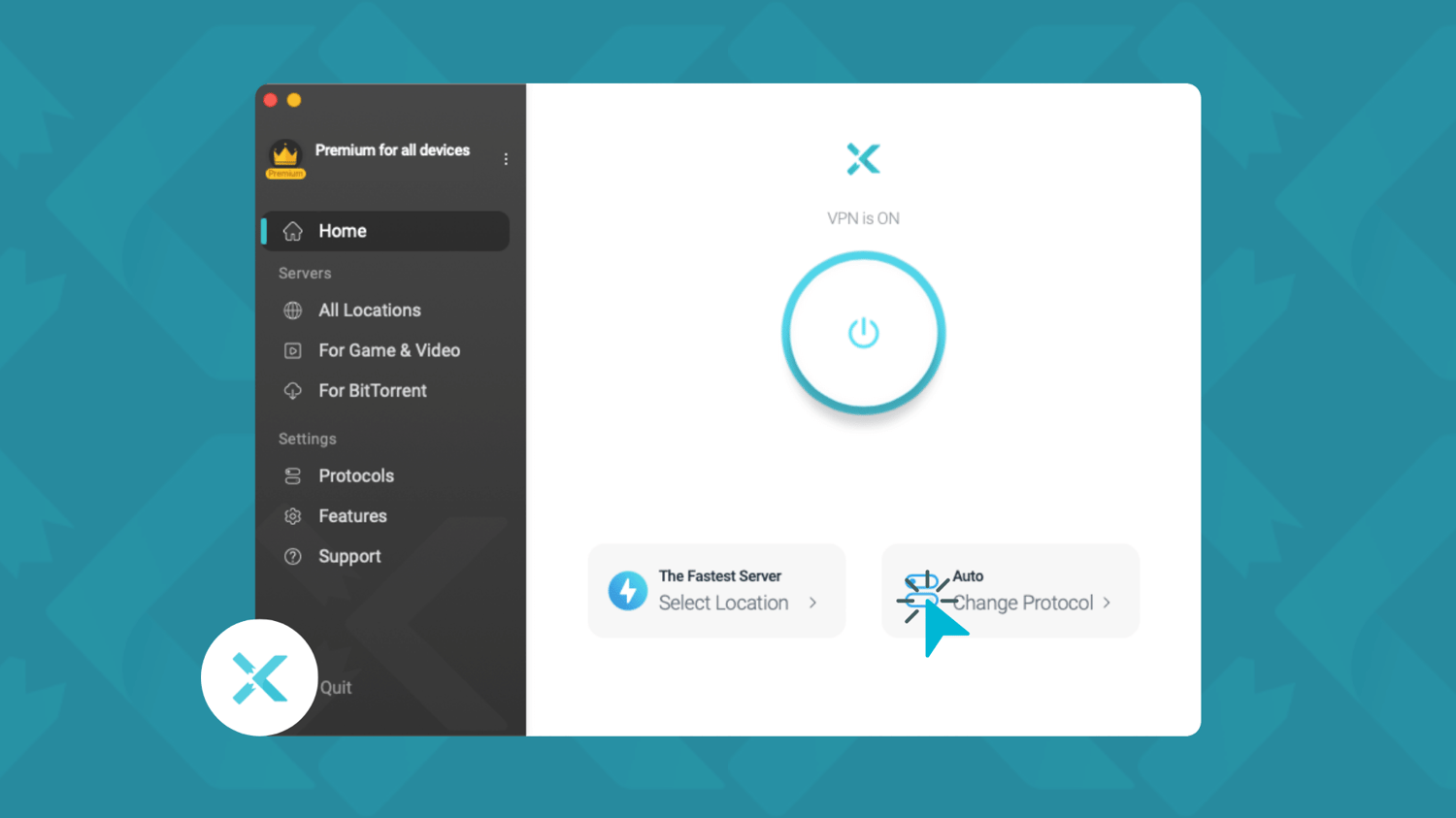
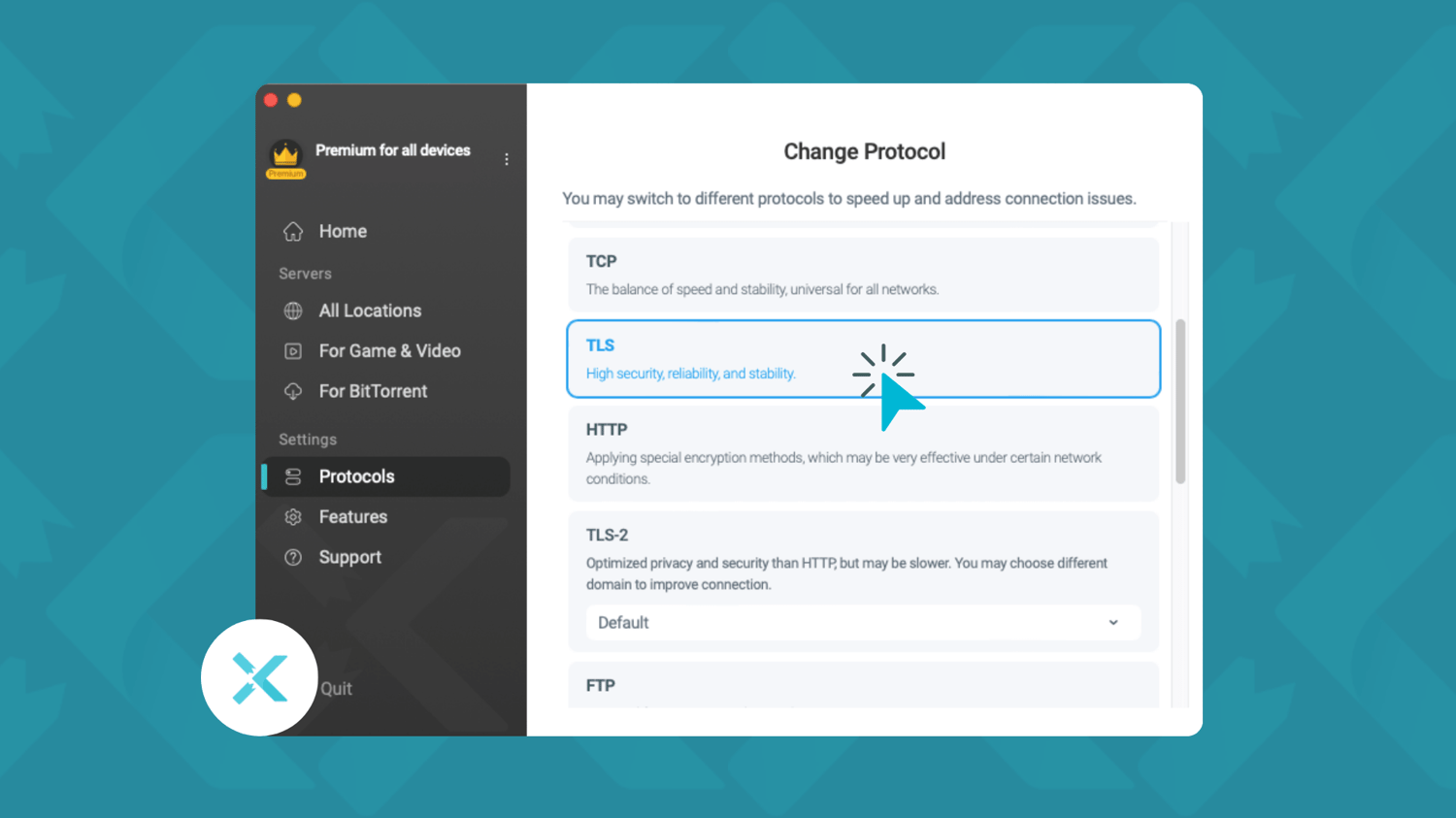
4. Connect to a server
With TLS 1.3 selected, you can now connect to any available server. X-VPN offers numerous servers across different regions, providing you with multiple options for a secure connection.
5. Enjoy enhanced security and speed
Once you're connected, you can start browsing, streaming, or working online with the added security and speed benefits of TLS 1.3. The tls tunnel ensures that your data remains encrypted and your online activities remain private.
6. Keep X-VPN updated
To maintain optimal performance and security standards, be sure to keep your X-VPN app up-to-date with regular updates.
By following these steps, you can effortlessly integrate TLS 1.3 into your daily Internet usage with X-VPN, enjoying a secure and fast online experience.
Future of internet security and the role of TLS
The future of Internet security is expected to be shaped by several key trends. These include the rise of artificial intelligence and machine learning in cybersecurity, the increasing threat of attacks on Internet of Things (IoT) devices, and the rising demand for cybersecurity skills. The potential for large-scale data breaches and the associated social and political fallout is also a major concern, leading to increased regulation and a strategic focus on cybersecurity at the board level.
X-VPN uses Transport Layer Security (TLS) 1.3 to provide a secure, encrypted connection between a user's device and the Internet, protecting all Internet traffic and user data.
FAQ
What is Transport Layer Security (TLS), and why is it important for Internet security?
Transport Layer Security (TLS) is a method of encryption that ensures secure communication over the Internet. It plays a crucial role in Internet security by encrypting data and verifying the authenticity of communicating parties, thereby protecting data integrity and privacy.
How does TLS 1.3 compare to TLS 1.2?
TLS 1.3 offers significant technical differences and advancements compared to TLS 1.2. These include improvements in the TLS handshake process, Zero Round-Trip Time (0-RTT) key exchanges, and support for more secure cryptographic ciphers, resulting in enhanced security and improved performance.
In what real-world scenarios is TLS 1.3 used?
TLS 1.3 finds application in industries such as finance, healthcare, e-commerce, and government sectors. It secures online transactions, protects confidential information, and ensures the integrity of communication between users and servers.
How can I use TLS 1.3 with X-VPN?
This section provides a comprehensive guide on how to use TLS 1.3 with X-VPN. It includes detailed instructions from downloading and installing X-VPN to selecting the TLS 1.3 protocol for enhanced security. Usage tips for configuring optimal security settings are also provided.
What is the future of Internet security and the role of TLS?
The future of Internet security holds exciting trends, including advancements in encryption protocols like TLS. TLS is expected to play a more significant role in securing online communication as the threat landscape evolves. X-VPN is committed to adapting to emerging security requirements, ensuring top-tier protection for its users.
Follow Us on Social Media
Recent Articles
How to Use VPNs for Secure Social Media Management
Jul 29, 2024 | 9 mins to readHow to Set Up a VPN on Windows 10/11?
Aug 14, 2024 | 7 mins to readHow to Use Signal App in Russia: Solve Signal Ban
Aug 12, 2024 | 4 mins to read30 Best FMovies Alternatives in 2024 (Still Working)
Aug 12, 2024 | 14 mins to readAccess anything anywhere anonymously with X-VPN
24/7 one-one live chat support
Ultimate protection for 5 devices
Access to all worldwide contents
8000+ servers at 225 locations
30-DAY MONEY-BACK GUARANTEE

